So, you’ve launched several marketing campaigns. Now you’re wondering, what’s the best way to track marketing campaigns?
By tracking and monitoring social and web conversations during and after your campaigns, you’ll see real-time results on what’s effective and what’s not. This lets you make decisions on the spot, so you can either react immediately or plan better for your next campaign. This article will detail the steps you should take during and after your marketing campaigns.
Read more Media Monitoring: The Ultimate Guide

Why Should You Track Marketing Campaigns?
Next to traditional campaign measurement, it’s equally as important to analyze the conversations taking place online and in real-time.
This data can significantly help marketers:
- Evaluate the success of their campaigns to improve ROI
- Track marketing campaigns engagement and conversations, identifying inclusion opportunities as you go
- Stay aware of trends or even potential crises arising
- Attain a deeper understanding of audience responses that will be used to improve future campaign strategies
Before Marketing Campaigns
Before we jump into what you should do during and after your marketing campaigns, let’s (really) shortly examine the steps you should take before your campaigns. But we’ve written a piece about this in detail.
Read more How to Use Media Monitoring to Boost Your Communication Strategy
Approach
Before you launch a marketing and communications campaign, approach the media or contact an influencer, you need to establish your current brand reputation, define your objectives and identify your key audiences.
Research
Nowadays, it’s not enough for you to be an expert on your brand, product, or service. Today, you also need to research your industry, your local and international media landscape, and the interests and activities of your target audience. Also, you need extensive knowledge of your competitors and their actions to know how you can build upon their successes or failures.
Theory and Practice
Now, before you fully launch your marketing campaign fully online, think about the following: how robust is your marketing and communications strategy? Are you prepared for a change in the market, an unexpected response, or even a crisis? What are the possible threats and/or challenges, and have you briefed your team just in case? Do you know how you’re going to track marketing campaigns?
Today, online conversations among consumers, influencers, and the media move incredibly fast, so marketers and PR professionals must be proactive in their engagement and crisis management approach.
Things to consider
- What if a journalist asks a difficult question?
- What if an influencer partners with a competitor?
- What if your customers boycott your brand?
- What if your CEO says something online or in the media?
- What if an online advertisement is taken the wrong way and goes viral?
Be prepared to evolve
Modern PR professionals, marketing executives, and business owners must be agile and open to change. Change is the only constant in an online environment where news breaks instantly and consumers can target your brand without repercussions. Are your marketing and communications plan tweakable?
Read Everything You Need to Know About Marketing of Financial Services
During Marketing Campaigns
During marketing campaigns, all the excitement happens—many tweets, blog posts, articles, etc. However, nobody has the time or energy to manage these manually, so companies rely on media monitoring tools.
Read 9 Marketing Assets that Every Company Should Have
Monitor conversations
When you’ve set up your campaigns, your immediate next step would be to set up your media monitoring tool to track marketing campaigns. This means setting up your tool to track specific keywords you’ll be using for your campaign.
This will include hashtags and your brand name but may also include specific influencers you’re working with, competitors, or broader industry terms. You can also track particular pages you want to monitor closely. This way, you get ready to start collecting all the data surrounding your campaign.
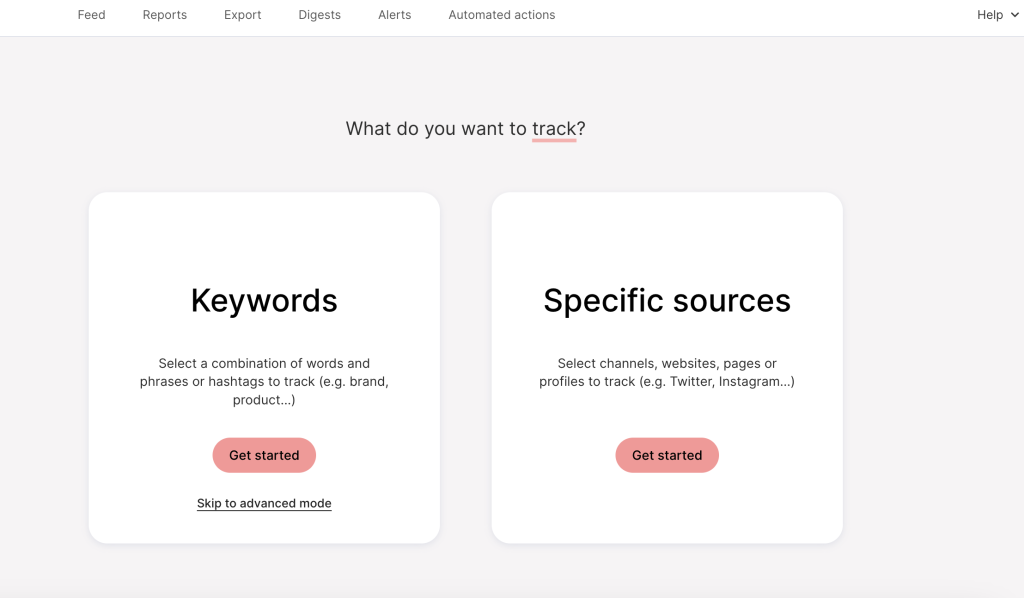
It’s super important to be as specific as possible when setting up your keywords for tracking. Be aware of anything similar that you’d want to exclude or include. This is where Boolean operators come in place. But if you’re not familiar with these, we have a whole team dedicated to helping you out.
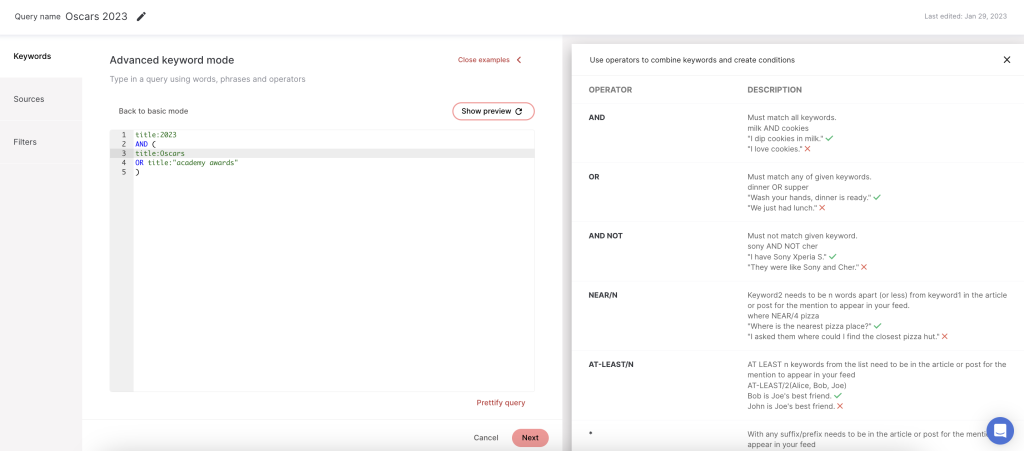
Read Explaining Boolean Operators With Pizza
However, it’s not enough to just collect all this information in one place. It’s best to establish a system. Use separate folders to segment conversations. Differentiate folders for good reviews and customer feedback, complaints or negative mentions, press or news mentions, or anything else you want to prioritize. Doing this will help you put all the data you collect in context.
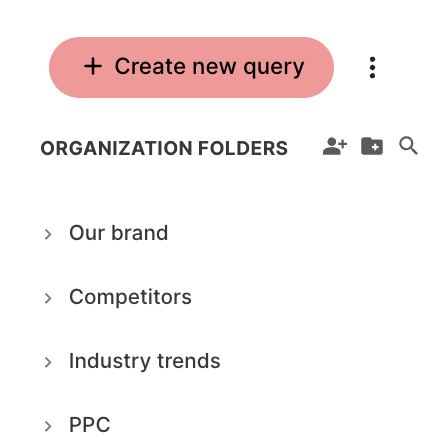
React in real time
For a long time, media monitoring was not real-time. It used to be done manually, and it was called press clipping, or it was done through Google alerts (LINK). So you’d have to wait until the daily report to know when your brand has been mentioned.
Modern monitoring tools such as Determ have changed this. They allow you to know when someone mentions anything connected to you anywhere online, in real-time. And this is incredibly important since conversations on social move quickly. And a quick response can make a huge difference! This way, you can divert the narrative if it turns wrong.

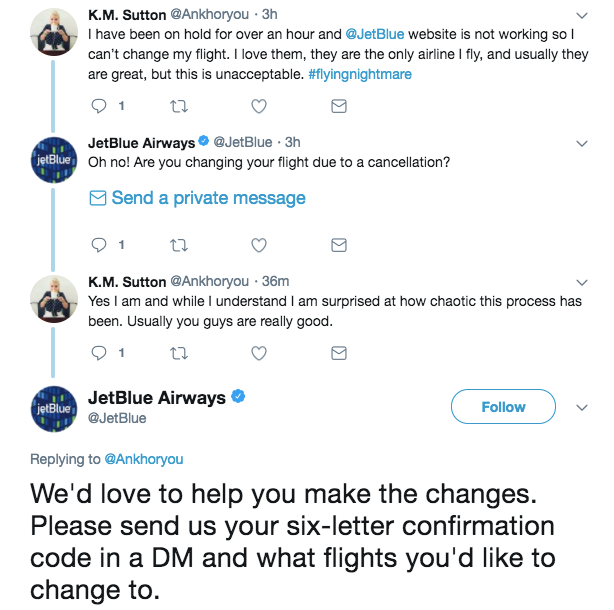
Build awareness
Ok, so by now, you’ve set up your tool to track marketing campaigns and the revolving conversations. But what more can you do? If your goal is to increase buzz, you could try and monitor a wide range of subjects than just the brand name. You can find people talking about topics that are related to yours and introduce yourselves.
For example, say you’re working for the PR team of a fast food restaurant chain McRonalds (totally ambiguous, I know). Both you and your competitor (let’s call them Dorothy’s;)) are running a new coupon campaign. Someone leaves a comment saying something negative about the deals they’re offering, something where your coupons take the win. You see where I’m going with this, right?
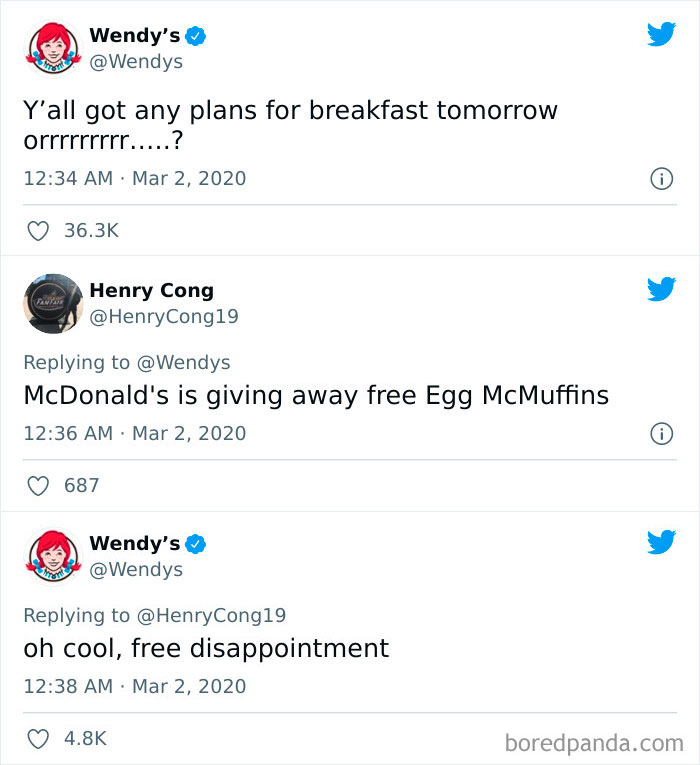
This can apply to a variety of different topics and products. Responding to customers is one of the best ways to boost their engagement on social media. Even if it’s sassy 🙂
Other than that, your monitoring tool will also help you identify influencers as you track your campaign. This way, you can connect with prominent publications or people already talking about your brand. Find and connect with them, as this can only benefit your brand.
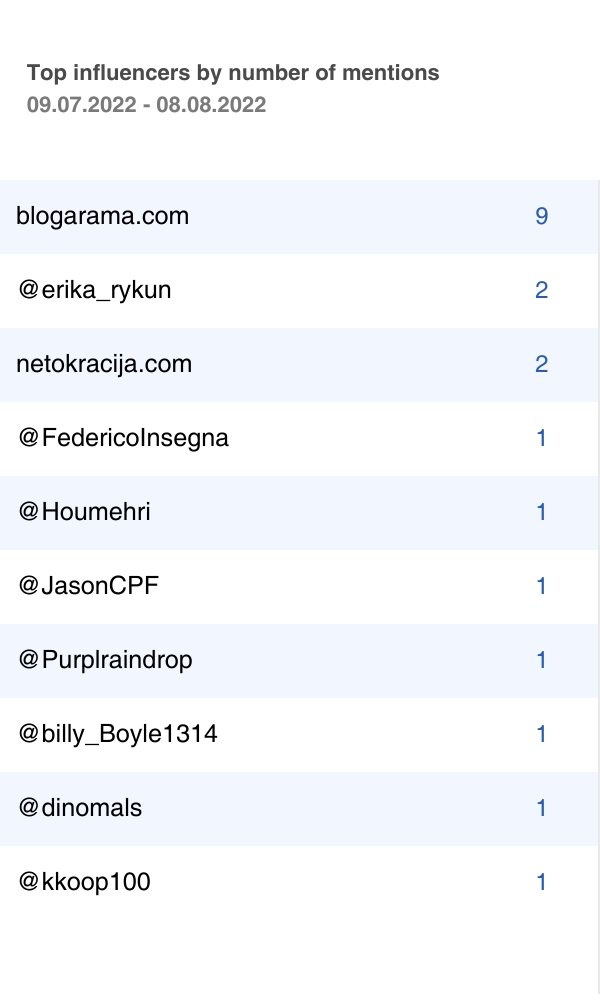
After Marketing Campaigns
After the campaign is over, much of the excitement has evaporated. But that doesn’t mean your work is done here. Now is the time to evaluate your performance and see what was most effective and didn’t really work. It’s time to prepare a report for your C-suite or make it (pretty) comprehensive for you.
How do you define return on investment? The bigger picture could be obscured if you’re focusing on one or two metrics, such as traffic or sales. There’s always a lot to learn from a campaign, which means looking at results from all angles.
4 ways marketers can use online consumer insights to track marketing campaigns and their performance:
- How much are people talking about the campaign?
- How do people feel about the campaign?
- What are people saying about the campaign?
- How is the campaign influencing brand perception?
Let’s see how media monitoring tools can help you analyze your performance.
Metrics that track marketing campaigns’ performance
Monitoring can help you understand the most compelling part of your campaigns and what can be improved next time. Here are a few metrics that should matter the most:
Mentions; or did it drive conversation?
There are several KPIs that brands can measure through social analytics, but the most straightforward is the volume of mentions. It seems basic, but it can mean a lot. A spike in mentions will show you which specific strategy worked. And this metric can be compared in different ways.
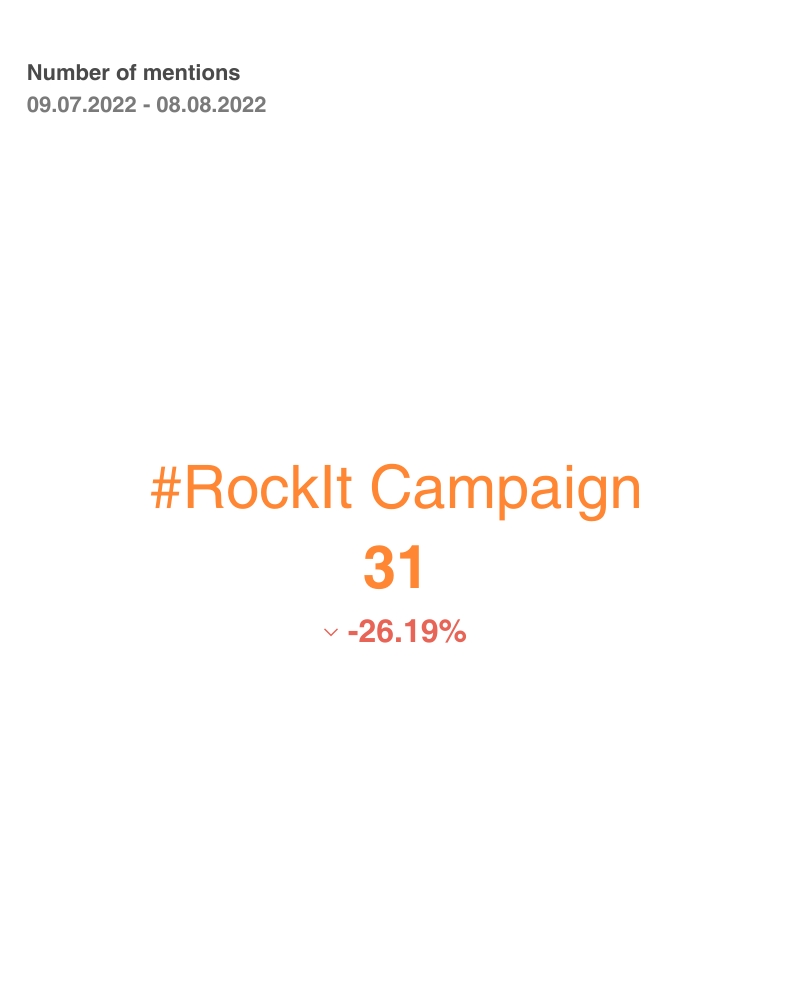
For example, you can compare the volume on different sources (and over time) or sentiment (and also over time). You may discover if a social network was more effective than expected.
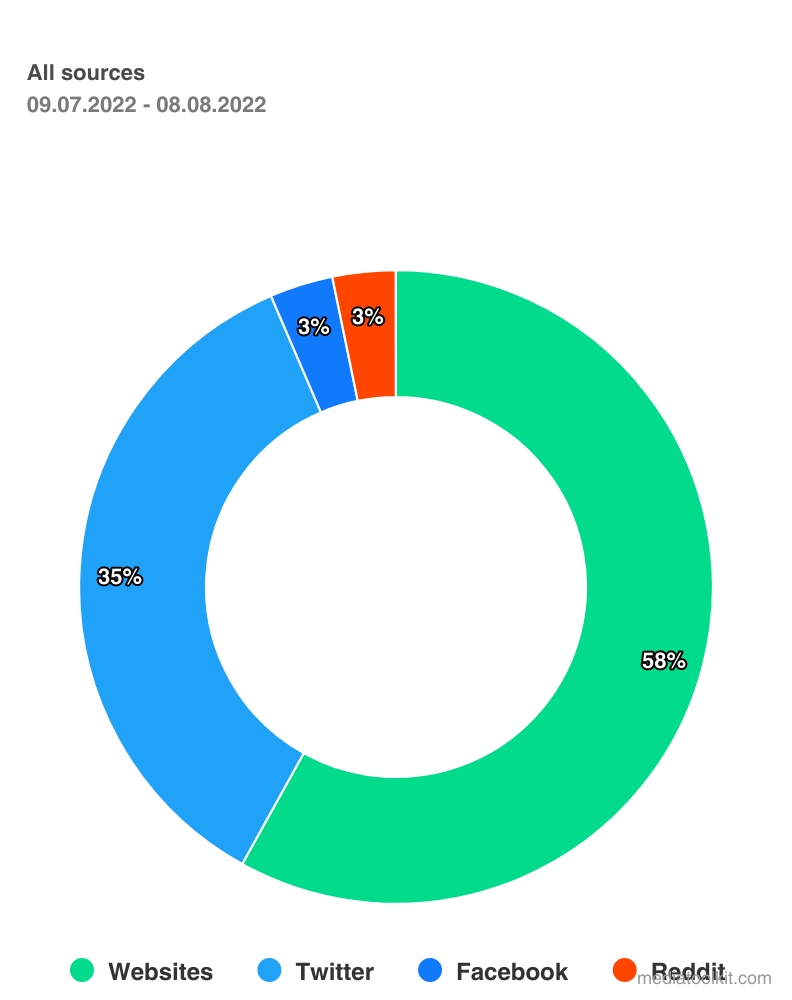
A great feature that Determ offers is that when you see a spike in your mentions, you can pinpoint that exact moment, access everything posted on it, and examine it thoroughly. The chart that will allow you to explore this is “mentions over time” or “mentions over time by source”.
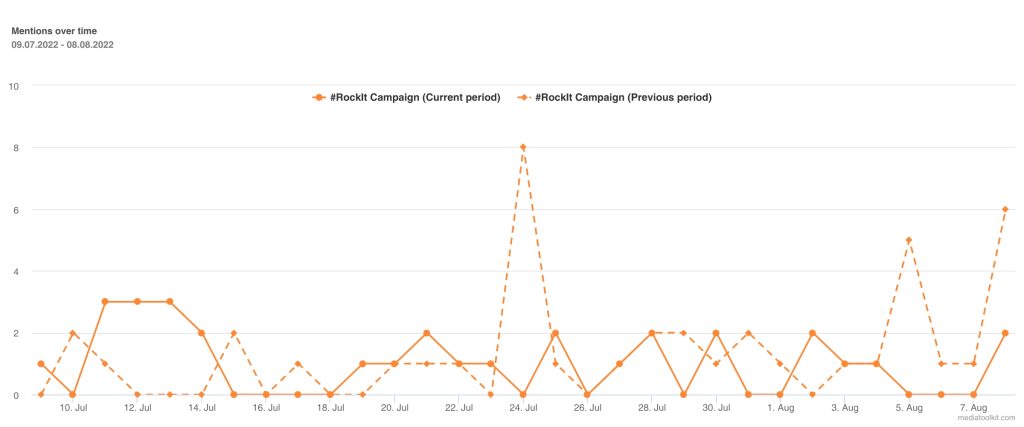
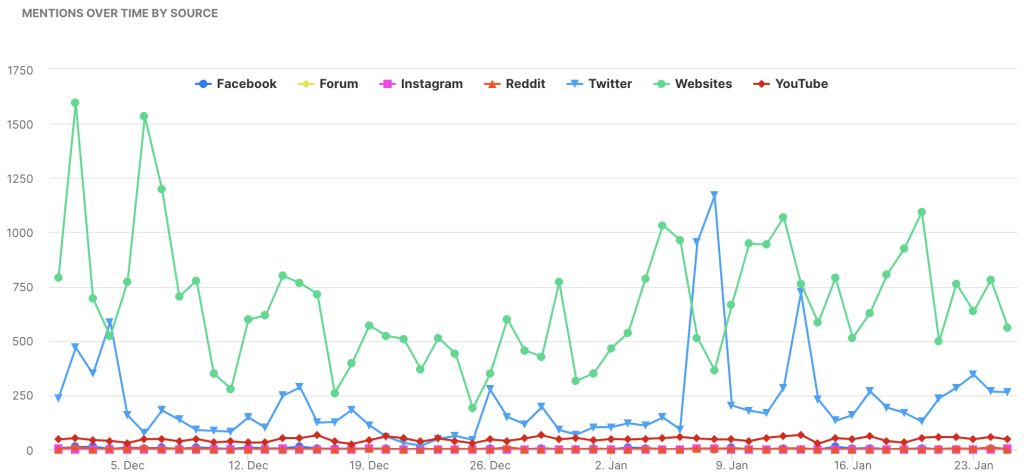
Determ also shows the impressions of a particular query. In the tool, impressions are described as the sum of all mentions’ reach. In our example, Nike had a spike in impressions on the 20th of July. A whopping 163 million impressions. What was this the result of? Nike had launched a line of new Air Jordan shoes in collaboration with Travis Scott called “Reverse Mocha”. But that was not it; according to the mentions we collected, Nike’s collaboration with Louis Vuitton by Virgil Abloh collection was also the topic of discussion on the day.
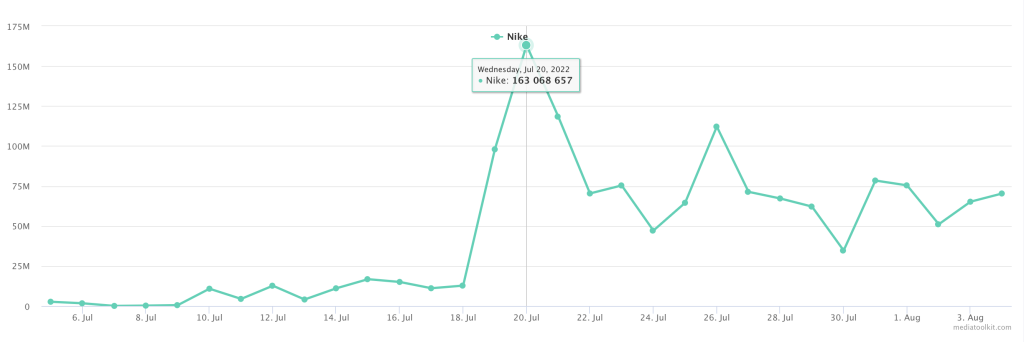
Sentiment; or how did people feel about the campaign?
Is every PR good PR? This is a topic we can discuss for days, but overall the goal of your marketing campaign is most likely positive sentiment. You want to make people feel good about your brand and ready to take the next step.

Different targeted groups communicate differently on different platforms. That’s why it’s essential to view this metric across several platforms when looking at the sentiment. This way, you’ll be able to understand which source is driving which type of conversation. If you’ve prepared your crisis communication methods before launching your campaigns, you’ll be ready for anything.
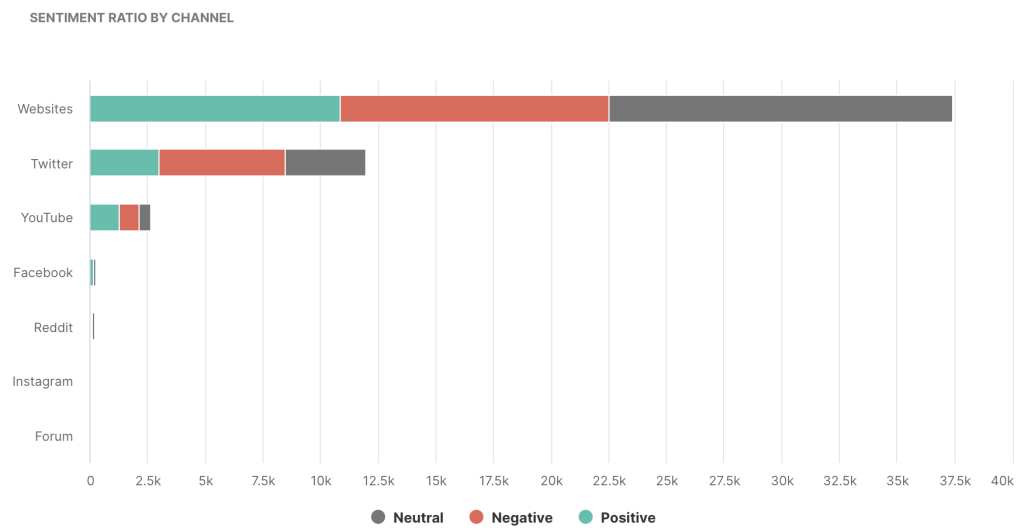
Determ will allow you to scatter this metric across a timeline to evaluate which event encouraged which sentiment. This way, you can understand what method to enhance and which to diminish.
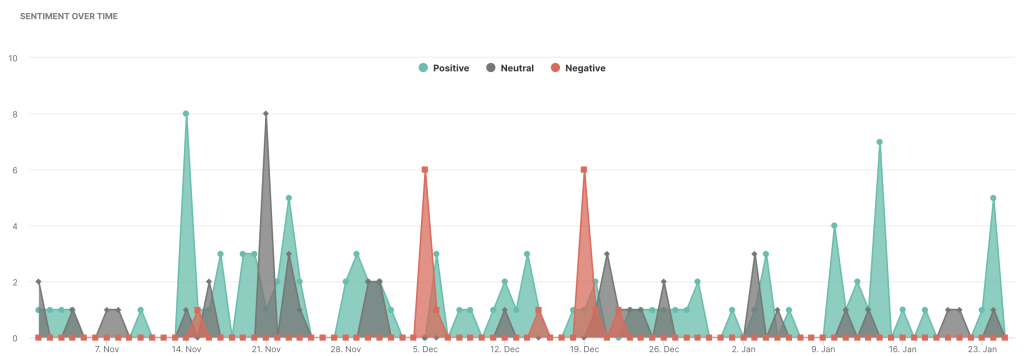
Word cloud; or what are people saying about the campaign?
Now you know how much people talked about your campaign and how they felt. The next thing you want to know is exactly what they’re saying.
Word cloud lets you define precisely which words have been said the most about your tracked keyword. Since all Determ’s charts are interactive, so is this one. The bigger the word, the bigger the number of mentions. When you click on each, you get a list of mentions with your keyword and this specific word.

Brand reputation
What about your brand reputation? Well, as it should, every campaign will affect your overall brand image. You should set up media monitoring tools to track your brand reputation, just like you’ve set up your queries to track marketing campaigns. You should monitor your:
- Company or brand name and common misspellings
- Products and services
- Key people
- PR and Marketing efforts (press releases, campaigns, hashtags, etc.)
- Competitors
- Industry news, trends, and buzzwords
- Other stakeholders.
After all, one campaign can make it or break it for a band. At the beginning of 2021., we witnessed Gillette’sGillette’s campaign #TheBestMenCanBe make their brand reputation skate on thin ice. Their aim was “based on changing settled behavior patterns that could cause unacceptable social behavior”. So, they changed their slogan from “The best men can get” to “The best men can be”. Have a look at the initial video ad:
Overall their message was aimed for the good, but some of the audience did not pleasantly welcome their messaging. It generated numerous mentions with the word “boycott”. Luckily, the campaign results were generally positive towards their reputation, and Gilette’s stock value skyrocketed. Check out our detailed analysis here.
Read more Brand Reputation 101: Monitoring, Analysis, and Management Tools
To Sum Up
It certainly isn’t the easiest to strike the perfect chord with your core audience. However, if you’ve done your research prior to the launch, you might be off to a good start. During and after your campaign, it’s important to always be aware of how your audience is feeling, what they might be saying about your campaign and how all of this can influence your brand reputation. So, using media monitoring tools to fully track marketing campaigns and the revolving conversations, might be the key to your brand’s success.
If you’d like to learn how to track your marketing campaigns with Determ, book a call with our experts and you’ll get a free trial to take the tool for a test ride. We’d be happy to provide all the help you need.



